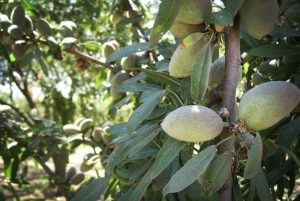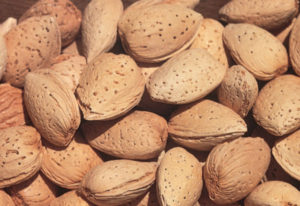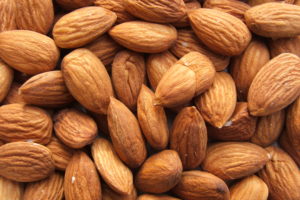Introduction of Almond: – The almond is a medium sized tree of rose family. It resembles the peach, plum and apricot. Just like the peach, the almond contains the edible seed in a hard outer shell. When reaching maturity. Almond hull splits open the almond nut can be easily separated from the hard shell once it is dried. There are two types of almond available
- Sweet almond
- Bitter almond.
Almonds are used for various purposes like in sweets, milk; nuts used in food and used producing oils, almond cultivation in India is restricted to selected hilly areas of are Kashmir region, Himachal Pradesh and Uttar Pradesh.
Health Benefits of Almonds: – Almonds are the most nutritious and healthiest nuts of all, considered a well balanced cholesterol free food, it also called king of nuts in India. Some of the health benefits of almonds are given below.
- Almonds may lower ‘bad’ cholesterol.
- Almonds may reduce heart attack risk.
- Almonds provide healthy fats and may aid in weight loss.
- Almonds provide good brain function.
- Almonds help build strong teeth and bones.
Local Names of Almond in India: – Badam Pappu (Telugu), Badam Paruppu (Tamil), Baasami (Kannada), Badam Kayu (Malayalam) Badam (Hindi, Marathi).
Commercial Varieties of Almonds in India: – Below are some of the commercial varieties of Almond cultivated in India. Non Pareil, Claifornia paper Shell, Merced, IXL, Shalimar, Makhdoom, Waris, Pranyaj, Other high yielding cultivars are Ne Plus Ultra, Primorskij, Peerless, Carmel, Thompson, Price, Butter, Monterey, Ruby, Fritz, Sonora, Padre and Le Grand.
Climate required for almond farming: – Almond requires climate having slightly hot summer temperature ranging from 30C to 35C and cool winters for plant growth and kernel filling. Unopened blossoms shall withstand cold up to – 2.2C, but blossoms at petal fall stage are damaged at 0.50 C to – 1.1 C. The blossoms can withstand temperature from -2.2 C to -3.3 C for a short time but if low temperature continuous for long hours they get damaged easily.
Soil and its Preparation in Almond farming: – Almonds grow in wide range of soils and the ideal PH range of soil is 7.0 to 8.5. Almond cultivation is best suitable for loamy, deep and well drained soils. Almond trees don not thrive well in heavy or poorly drained soils, but can be grown in average soils supplemented with Farm Yard Manure and with regular assured irrigation.
Plantation in Almond farming: – The grafted/budded almond plants should be planted in square system at a distance of either 6m X 6m (normal farmers planting system), 4.0m X 4.0m (Medium high density system), and 3.5m X 3.5m -2.5m (under high density planting system). Every 3rd row should be polarizer row. Before planting, pits of 3ft X 3ft X 3ft should dug up size during the month of September to October. The almond plants should be planted from Feb to March in the centre of the pit, provided by desired bamboo supports to protect the almond trees from winds and to grow straight.
 Training and pruning in Almond farming: –
Training and pruning in Almond farming: –
- At Almond planting time, head back the tree to 1 meter above the ground level.
- First dormant pruning
- Primary scaffold branches are retained along with few temporary branches below trunk, removing only those branches which compete strongly with primary scaffolds and the Almond tree is trained to a shape of modifies leader system. 1 year old wood is pruned every year in December to January when Almond tree is completely dormant and they produce most of the fruit on short spurs which stay fruitful for about five years.
Therefore, pruning should be done in such a manner that 1-5 of the fruiting wood is replaced every year. Prune in such a way that new wood with new spur growth is constantly replacing spur that are no longer fruitful or useful. To meet or achieve this, only prune or remove older tree branches that is 1.2 cm to 3.7 cm in diameter. Thin out very little of the smaller wood, except to remove unwanted suckers or water sprouts. The success of pruning in almond plantation can be judged in part by the length of new shoots over the entire tree every year, if other factors are not impacting growth.
Inter cropping in almond farming: – During the almond orchard pre-bearing stage, inter cultivation with several suitable crops are recommended for some extra income through sustainable utilization of inter spaces. The best inter crops in almond farming are like saffron, pea, pulses, carrot, seed production of turnip, knoll khol, mustard and bulb production of onion and garlic, and aromatic plants and medicinal plants like lave dine, lavender. Besides getting some extra income, the growing of legumes like pulses and pea will increase the soil fertility, turnips seed production and mustard augmenting to pollination by attracting bees, and growing some medicinal and aromatic trees like garlic, lavender, lave dine etc are acting as repellent to ant pests, insects and diseases.
Pollination Management in Almond farming: – In general, Almond trees are not self pollinating so therefore it is necessary to provide every 3rd row in each farm with pollinizer variety (33 percent pollinizer) so that their bloom should coincide with each other. The varieties which are generally used for commercial almond cultivation as pollinizer like, Jordanalo IXL, Waris, and Ne-Plus-Ultra. In addition, to this, placement of 4 to 6 beehives is found highly beneficial and can increase the fruit set and almond yield by 12 to 15%.
Manure and fertilizers in Almond farming: – Almond tree is a heavy feeder. Therefore, it requires and recommended the good amount of manures and fertilizers. It is best to apply well rotten Farm Yard Manure (FMY) in each tree at rate of 20 to 25 kg/tree during winter fall (Dec to Jan). Fertilizers doses should be applied on the basis of leaf nutrient analysis and soil test. However, usually the following recommendations may be adopted depending upon the age of the almond tree. Urea should be applied in 2 to 3 split doses. First half dose should be applied along with DAP (full) and MOP (full) at fortnight before expected blooming, second dose (1/4th) of Urea should be applies in May-June. Foliar spray of urea about 1.5 to 2% may also be given for promoting fruiting bud formation and subsequent growth in the next season.
Irrigation/Water supply in almond farming: – The critical stages of almond plantation which are most sensitive to water shortages are flowering (Feb to March) and fruit development (April-May-June).Therefore, watering must be provided during these stages for getting higher yield of quality almond nuts. The drip irrigation watering method found very efficient in almond farming, try to adopt drip irrigation for better water management.
Harvesting of Almonds: – At the end of July it begins to split open and between mid to late Augusts the splits widens which exposes the shell and this allows the nut dry. Therefore, more than 50% split stage; the nuts are normally harvested by manual plucking. Make sure it is dry for harvesting, rain may damage nuts quality. Harvesting is done knocking the branches with sticks or manually but care be taken to save the fruiting wood and branches while knocking the branches with sticks. Later on almond hull is removed manually.
Post harvest handling in Almond farming: – Just after almond harvesting, fruits requires hulling otherwise they will be damaged by fungal infection very quickly. Nuts are sun dried or dried by forced hot air until their moisture content reaches 5 to 7%. Poly tunnels with fan can also be used for best drying. Almond nuts are then de-hulled and shelled.
Yield of Almond Crop: – Almond average yields UP to 1 to 2 tones/ha.
Bottom Line: – For commercial crops, you should take good care and it may be little expensive to cultivate almonds in bigger way.
